The Smart Workplace Market is estimated to be valued at USD 219.8 billion in 2025 and is projected to reach USD 920.7 billion by 2035, registering a compound annual growth rate (CAGR) of 15.4% over the forecast period.
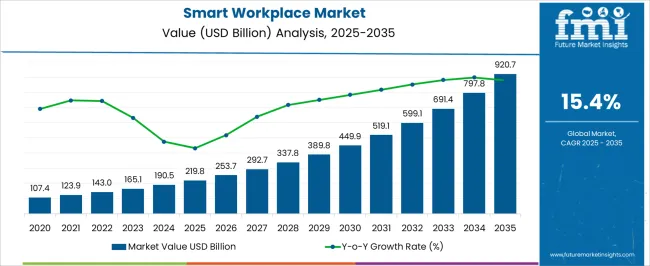
| Metric | Value |
|---|---|
| Smart Workplace Market Estimated Value in (2025 E) | USD 219.8 billion |
| Smart Workplace Market Forecast Value in (2035 F) | USD 920.7 billion |
| Forecast CAGR (2025 to 2035) | 15.4% |
The smart workplace market is witnessing significant momentum, fueled by rapid digitalization of enterprises and the growing need to enhance productivity, sustainability, and employee well-being through technology-driven environments. The integration of IoT, AI, and cloud-based systems into workplace infrastructure is enabling organizations to create intelligent environments that adapt in real time to user needs. Increasing corporate emphasis on energy efficiency, operational flexibility, and hybrid working models is accelerating the adoption of smart workplace solutions across industries.
Investments in smart building infrastructure and connected systems are expanding as companies seek to reduce operational costs while improving collaboration and workplace safety. Governments and regulatory bodies are also encouraging smart infrastructure adoption through energy efficiency mandates and green building initiatives.
As the future of work continues to evolve, the demand for integrated workplace technologies that combine automation, analytics, and sustainability is expected to expand rapidly The market is therefore positioned for strong growth, with enterprises adopting scalable, software-driven platforms to support long-term operational resilience and agility.
The smart workplace market is segmented by smart technologies, buildings, and geographic regions. By smart technologies, smart workplace market is divided into Smart Lighting Systems, Laptops, Tablets, Energy Saving Systems, Security Systems, and Communication Systems. In terms of buildings, smart workplace market is classified into Smart Buildings and Other Buildings. Regionally, the smart workplace industry is classified into North America, Latin America, Western Europe, Eastern Europe, Balkan & Baltic Countries, Russia & Belarus, Central Asia, East Asia, South Asia & Pacific, and the Middle East & Africa.
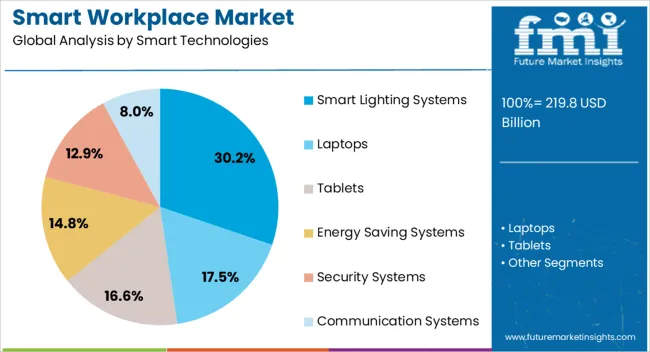
The smart lighting systems segment is expected to hold 30.2% of the smart workplace market revenue share in 2025, positioning it as the leading smart technology. This dominance is being reinforced by the growing demand for energy-efficient solutions that reduce electricity consumption while enhancing user comfort and workplace productivity. The ability of smart lighting systems to integrate with IoT platforms and building management systems allows real-time adjustments based on occupancy, daylight availability, and employee preferences, thereby improving efficiency and operational control.
Cost savings achieved through automated dimming, scheduling, and remote management are further contributing to widespread adoption. Growing focus on sustainable workplace practices and compliance with green building standards has also been a major driver for this segment.
Continuous innovation, such as the integration of sensor-based analytics and AI-driven automation, is enhancing functionality and enabling predictive maintenance As organizations place greater emphasis on reducing carbon footprints while creating adaptive and employee-friendly workplaces, smart lighting systems are expected to remain the most significant smart technology within the overall smart workplace ecosystem.
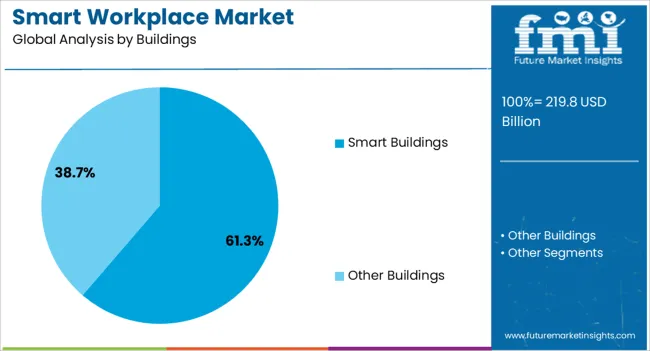
The smart buildings segment is projected to capture 61.3% of the smart workplace market revenue share in 2025, making it the leading building category. This segment’s dominance is being driven by the integration of interconnected systems that optimize energy use, security, space utilization, and overall workplace management. Enterprises are increasingly investing in smart building solutions to create sustainable and adaptive work environments that align with global efficiency standards.
The ability to consolidate multiple functions such as HVAC control, lighting, security, and occupancy management into a unified platform is providing operational flexibility and cost savings. Adoption is being further accelerated by rising regulatory requirements for green building certifications and energy efficiency compliance across major markets.
Growing demand for enhanced employee safety and comfort, particularly in hybrid and flexible working models, is reinforcing adoption in large office complexes and corporate campuses As organizations prioritize long-term operational resilience and sustainable infrastructure, smart buildings are expected to remain the dominant contributor to market revenue, underlining their central role in the evolution of the smart workplace.
Smart workplace is a workspace, which exploits the use of technology and networking for all the works in the offices. Smart workplace enables the employees to do their day-to-day works more efficiently with smart devices, better global collaboration.
The early traditional work places included so much complications and wastage of resources. With the introduction of new technologies and gadgets like laptops, tablets, LED monitors and better internet connectivity has changed the face of traditional workplace by eliminating the bulky monitors and paper works making better utilization of space in the organizations.
With the trends of flexible working hours and work from home concepts, the employs do not have to commute from far places to workplace; instead, they can work more efficiently from home saving time and increasing productivity.
The adoption of smart technologies such as, smart lighting, better internet connectivity in the workplace will also contribute to saving energy costs in the buildings. The key factors for a smart workplace are enhancing the strategy & ownership, devices & mobility, applications & cloud services, data & security, collaborative services and user care.
The global market for smart workplace will register a healthy CAGR over the forecast period.
The global smart workplace market is primarily driven by the need of energy savings at the workplace, better productivity by using new technologies like tools for data storing and communications, reduce cost, and make optimum use of resources available at workplace.
The increasing demand for flexibility in working is another factor, which is driving the market for global workplace globally as it saves time of the employees commuting from home to workplace and can utilize that time working from home.
The need for more sustainable workplaces is also driving the market for smart workplaces. For example, Hewlett-Packard consolidated its two working places into a single location, which resulted in considerable reduction in amount of carbon dioxide emissions hence causing less harness to the environment.
Based on the geographic regions, global smart workplace market is segmented into seven key market segments namely North America, Latin America, Western Europe, Eastern Europe, Asia Pacific, Japan, and Middle East & Africa.
Among the aforementioned regions, North America market for smart workplace currently holds the largest market share with adoption of new technologies and regulations for sustainable workplace in the region.
Asia-Pacific market for smart workplace is followed by the North American market, and it is expected that the Asia-Pacific market for smart workplace will account for largest market share by the end of forecast period.
The adaptability of smart work place in the other regions such as Latin America, Middle East Africa is comparatively slow as compared to other regions. However, these regions will show moderate growth rates over the forecast period.
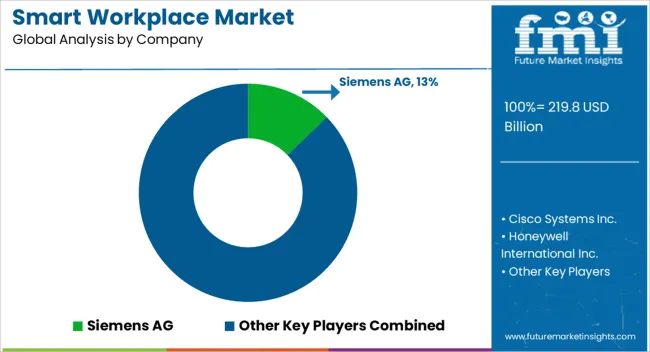
Some of the major players identified in the global automotive seating systems market includes, Johnson Controls Inc., Cisco Systems Inc., Siemens AG, Schneider Electric S.A., and ABB Ltd. among others.
The research report presents a comprehensive assessment of the market and contains thoughtful insights, facts, historical data, and statistically supported and industry-validated market data. It also contains projections using a suitable set of assumptions and methodologies.
The research report provides analysis and information according to categories such as market segments, geographies, types, technology and applications.
The report is a compilation of first-hand information, qualitative and quantitative assessment by industry analysts, inputs from industry experts and industry participants across the value chain. The report provides in-depth analysis of parent market trends, macro-economic indicators and governing factors along with market attractiveness as per segments. The report also maps the qualitative impact of various market factors on market segments and geographies.
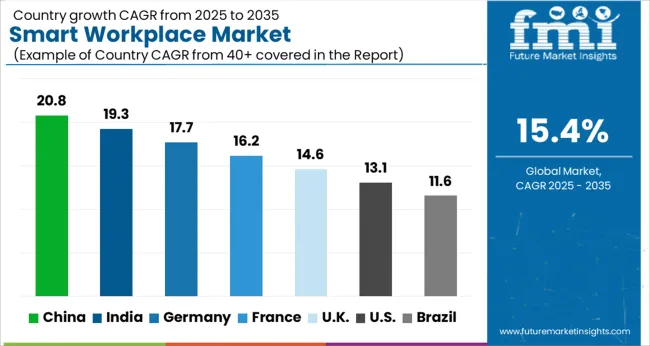
| Country | CAGR |
|---|---|
| China | 20.8% |
| India | 19.3% |
| Germany | 17.7% |
| France | 16.2% |
| UK | 14.6% |
| USA | 13.1% |
| Brazil | 11.6% |
The Smart Workplace Market is expected to register a CAGR of 15.4% during the forecast period, exhibiting varied country level momentum. China leads with the highest CAGR of 20.8%, followed by India at 19.3%. Developed markets such as Germany, France, and the UK continue to expand steadily, while the USA is likely to grow at consistent rates. Brazil posts the lowest CAGR at 11.6%, yet still underscores a broadly positive trajectory for the global Smart Workplace Market. In 2024, Germany held a dominant revenue in the Western Europe market and is expected to grow with a CAGR of 17.7%. The USA Smart Workplace Market is estimated to be valued at USD 76.4 billion in 2025 and is anticipated to reach a valuation of USD 261.3 billion by 2035. Sales are projected to rise at a CAGR of 13.1% over the forecast period between 2025 and 2035. While Japan and South Korea markets are estimated to be valued at USD 9.9 billion and USD 6.0 billion respectively in 2025.
| Item | Value |
|---|---|
| Quantitative Units | USD 219.8 Billion |
| Smart Technologies | Smart Lighting Systems, Laptops, Tablets, Energy Saving Systems, Security Systems, and Communication Systems |
| Buildings | Smart Buildings and Other Buildings |
| Regions Covered | North America, Europe, Asia-Pacific, Latin America, Middle East & Africa |
| Country Covered | United States, Canada, Germany, France, United Kingdom, China, Japan, India, Brazil, South Africa |
| Key Companies Profiled | Siemens AG, Cisco Systems Inc., Honeywell International Inc., ABB Ltd., Schneider Electric SE, Johnson Controls International, Crestron Electronics, Signify N.V. (Philips Lighting), Legrand SA, IBM Corporation, Microsoft Corporation, Siemens Smart Infrastructure, Google (Google Cloud IoT), and Samsung SDS |
The global smart workplace market is estimated to be valued at USD 219.8 billion in 2025.
The market size for the smart workplace market is projected to reach USD 920.7 billion by 2035.
The smart workplace market is expected to grow at a 15.4% CAGR between 2025 and 2035.
The key product types in smart workplace market are smart lighting systems, laptops, tablets, energy saving systems, security systems and communication systems.
In terms of buildings, smart buildings segment to command 61.3% share in the smart workplace market in 2025.






Full Research Suite comprises of:
Market outlook & trends analysis
Interviews & case studies
Strategic recommendations
Vendor profiles & capabilities analysis
5-year forecasts
8 regions and 60+ country-level data splits
Market segment data splits
12 months of continuous data updates
DELIVERED AS:
PDF EXCEL ONLINE
Smart Locks Market Size and Share Forecast Outlook 2025 to 2035
Smart Sprinkler Controller Market Size and Share Forecast Outlook 2025 to 2035
Smart Indoor Gardening System Market Size and Share Forecast Outlook 2025 to 2035
Smart Building Delivery Robot Market Size and Share Forecast Outlook 2025 to 2035
Smart Watch Market Size and Share Forecast Outlook 2025 to 2035
Smart Label Market Size and Share Forecast Outlook 2025 to 2035
Smart Mat Market Size and Share Forecast Outlook 2025 to 2035
Smart Water Management Market Size and Share Forecast Outlook 2025 to 2035
Smart Built-In Kitchen Appliance Market Size and Share Forecast Outlook 2025 to 2035
Smart Cold Therapy Machine Market Size and Share Forecast Outlook 2025 to 2035
Smart Personal Assistance Devices Market Size and Share Forecast Outlook 2025 to 2035
Smart Speaker Market Size and Share Forecast Outlook 2025 to 2035
Smart Vehicle Architecture Market Size and Share Forecast Outlook 2025 to 2035
Smart City Platforms Market Size and Share Forecast Outlook 2025 to 2035
Smart Doorbell Market Size and Share Forecast Outlook 2025 to 2035
Smart Water Monitoring Market Size and Share Forecast Outlook 2025 to 2035
Smart Welding Monitoring Solution Market Analysis - Size, Share, and Forecast Outlook 2025 to 2035
Smart Behind-The-Ear Hearing Aid Market Size and Share Forecast Outlook 2025 to 2035
Smart Pill Box Market Size and Share Forecast Outlook 2025 to 2035
Smart Medical Mattress Market Size and Share Forecast Outlook 2025 to 2035

Thank you!
You will receive an email from our Business Development Manager. Please be sure to check your SPAM/JUNK folder too.
Chat With
MaRIA